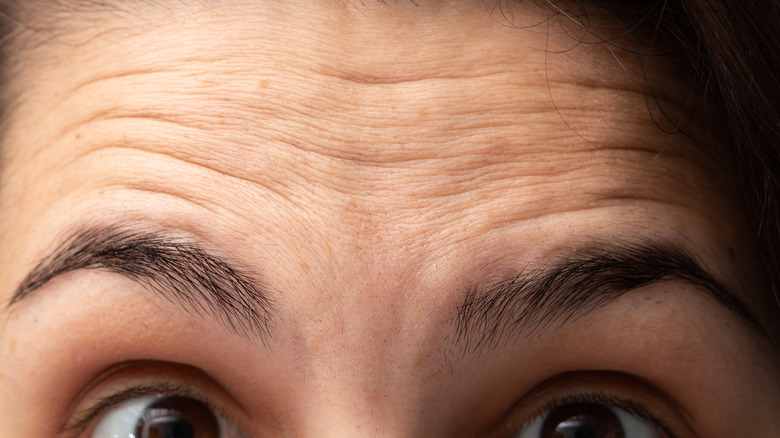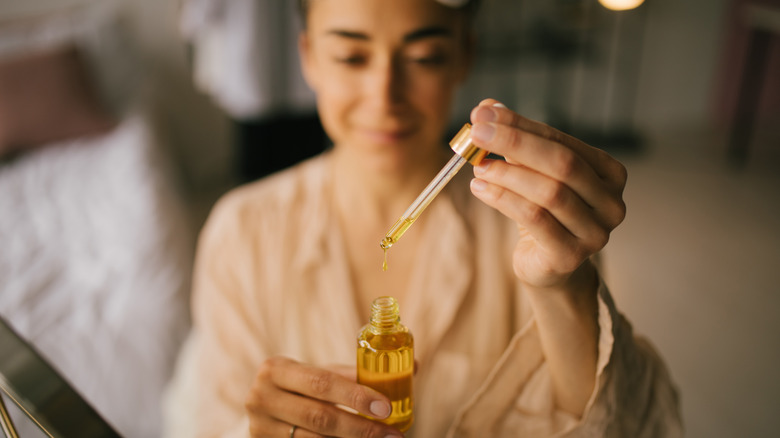Easy Tips For Preventing Forehead Wrinkles (SPF Is Key!)
We may receive a commission on purchases made from links.
Your skin begins to exhibit signs of aging around the age of 25, so it's normal to worry about preventing frown lines and wrinkles in your 20s, according to Dermalogica. Forehead wrinkles typically appear as horizontal creases close to your hairline or vertical lines in between your eyebrows, and they commonly occur due to a decrease in collagen production.
It goes without saying, therefore, that the most obvious tip for preventing wrinkles involves a strategic skincare routine, but there is more to skin health than a luxurious moisturizer. Wrinkles appear due to different causes, many of which are unrelated to age. These include genetics, repetitive movements, and lifestyle choices.
Preventing and treating wrinkles, regardless of their cause, requires due diligence that many people struggle with, particularly during the whirlwind of their 20 and 30s when healthy habits become less of a priority. But these critical years set the foundation for your skin's health as you grow older and begin to notice more fine lines and creases. If you want to prevent forehead wrinkles and keep those dreaded "eleven" lines at bay, then you'll need to remain consistent with these essential lifestyle changes and take a hard look at your current skincare regimen.
Turn that frown upside down
Repetitive muscle movements and facial expressions certainly play a major role in the formation of wrinkles. You may have even come across videos online where skincare influencers and dermatologists tell you to avoid making facial expressions that lead to creases in the skin, which seems like overkill — or is it?
"Forehead wrinkles are caused by repetitive crunching of the frontalis muscle, and are exaggerated in individuals with bulkier muscle mass and those who are very expressive," New York-based dermatologist Brian Hibler tells Harper's Bazaar. Typically, expressive individuals will notice more wrinkles due to repetitive eyebrow-raising or scrunching. The most common type of wrinkles on the forehead appears as "eleven" lines or frown lines in the glabellar region, the stretch of skin in between your eyebrows, according to the American Academy of Facial Esthetics. Frown lines are also common if you tend to squint while performing daily tasks which require concentration.
But suppressing all physical manifestations of emotion is hardly a feasible or healthy solution. So, while you cannot control your facial expressions at all times, what you can do is consciously smooth out your forehead whenever you do catch yourself holding a frown or squinting for too long, with the goal of forming a habit of relaxing your facial muscles.
Manage stress and anxiety
Repetitive facial movements will inevitably lead to wrinkles, but stress drastically speeds up the process. In fact, leading a stressful lifestyle can make you appear 3.5 years older, according to Murad Skincare. Findings from a 2021 study published in the "International Journal of Molecular Sciences" also indicate that stress decreases skin elasticity as increased levels of cortisol actually degrade collagen and reduce new collagen production.
On top of the physical repercussions of stress and anxiety, the emotional repercussions only make matters worse. Stressed individuals will carry more facial tension around the forehead, eyes, and lips, so they are more likely to furrow their brows and exhibit the telltale "elevens" lines (via Healthline). The combination of a loss of collagen with chronic tension encourages premature aging. In this case, developing an awareness of your facial muscles will help you identify and address feelings of stress or anxiety. Use this awareness to ground yourself and practice stress-reducing techniques such as mindfulness to manage your stress. Building a habit of turning inward to check in on your stress levels throughout the day may seem tedious, but your skin and your mind will thank you in the long run.
Use sun protection daily
You may not immediately notice the signs, but over time the accumulated effects of sun damage drastically increase the signs of skin aging, such as wrinkling and hyperpigmentation. Poor sun protection is one of the leading causes of aging as ultra-violet (UV) exposure causes 80% of the visible signs of aging, so sunscreen is your best friend and should be an established step in your everyday skincare routine, according to a 2013 study published in "Clinical, Cosmetic and Investigational Dermatology." Regularly applying sunscreen reduces the long-term consequences of sun exposure such as sunburns, skin cancer, and premature aging. To reap the maximum benefits of sunscreen, be sure to use one with a sun protection factor (SPF) of 30, at the least, and to reapply throughout the day.
Keep in mind, however, that not all sunscreens are made the same. Standard sunscreens only protect you from UVB or burning rays. Yale Medicine recommends broad-spectrum sunscreen, which protects you from both UVB and UVA rays. As the name suggests, UVA rays are primarily responsible for wrinkling and other signs of premature aging. And, unfortunately, these rays penetrate window glass so get into the habit of wearing sunscreen even if you will be mostly indoors, especially if you like to window gaze.
Support your skin from the inside
Believe it or not, diet can also cause forehead wrinkles as people who consume healthier foods age better than those who regularly consume sugary, nutrient-poor food, according to a 2020 study published in "Nutrients." The study indicated that an unbalanced diet will affect your skin's collagen production. Consuming large amounts of sugar, fat, and fried foods, leads to wrinkles and a loss of elasticity due to the accumulation of advanced glycation end products (AGEs), which are proteins that cause inflammation and impact skin structure.
Thankfully, the damage to your skin from a high-sugar diet can be reversed. Turning a new leaf and maintaining a healthy lifestyle decreases the production of AGEs by 25%, per findings shared in the 2020 study. Try increasing your intake of antioxidant-rich foods such as leafy greens, berries, avocados, and oysters. Drinking enough water and limiting substances that cause skin dehydration, which include caffeine and alcohol, can also reduce your chances of developing more wrinkles.
Don't slack on your skincare
First and foremost, toss out any harsh skincare products that damage the skin's delicate barrier. Your skin thins as you age and, therefore, requires more care, so try to be more mindful about misusing harsh exfoliating acids, especially if you are in your late 20s and 30s, per UCLA Health.
Next, ensure your cleanser and moisturizer contain ingredients that are safe for aging skin. Look for hydrating ingredients, specifically products with hyaluronic acid and ceramides. Be sure to include a vitamin C serum for the daytime, to protect against pollution and free radicals, and a dermatologist-recommended retinol, such as SkinMedica's Retinol Complex line, for the evening. As with any retinol product, begin with a low percentage and work your way upwards depending on your skin's tolerance. To enhance product absorption and avoid tugging on the skin, try gently patting your moisturizer and serums into the skin, as opposed to rubbing. Then, most importantly, follow up with sunscreen in the morning and reapply throughout the day.
And remember not to underestimate the power of a 'bare minimum' routine. Less is more when it comes to long-term skin health. The majority of products on the shelf contain harsh chemicals and ingredients that increase irritation and sensitivity over time, so select your skincare arsenal wisely to avoid skin barrier damage.





